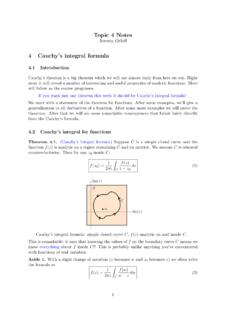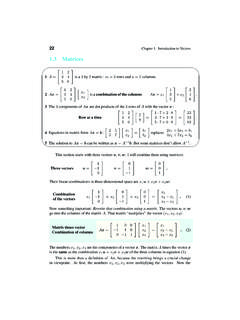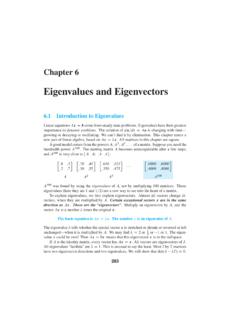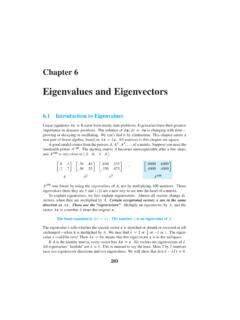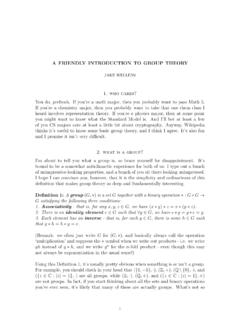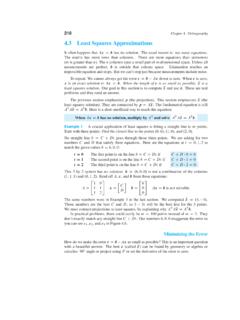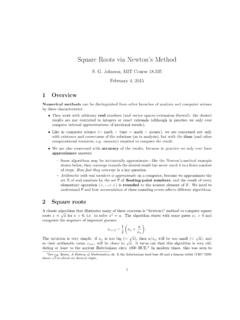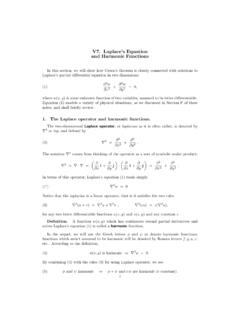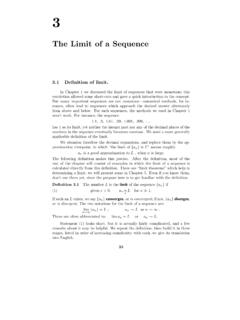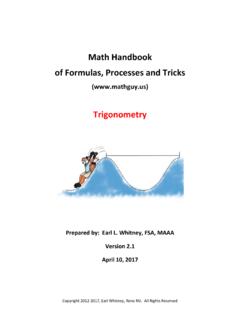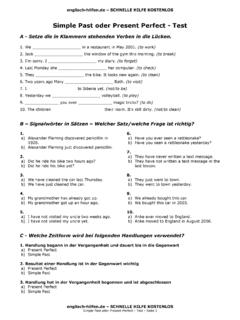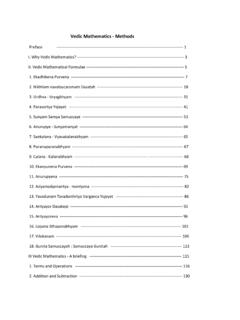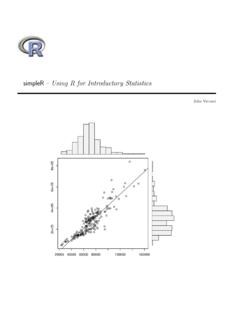Transcription of 7 Taylor and Laurent series - Massachusetts Institute of ...
1 Topic 7 NotesJeremy Orloff7 Taylor and Laurent IntroductionWe originally defined an analytic function as one where the derivative, defined as a limitof ratios, existed. We went on to prove Cauchy s theorem and Cauchy s integral revealed some deep properties of analytic functions, the existence of derivativesof all goal in this topic is to express analytic functions as infinite power series . This will leadus to Taylor series . When a complex function has an isolated singularity at a point we willreplace Taylor series by Laurent series . Not surprisingly we will derive these series fromCauchy s integral we come to power series representations after exploring other properties of analyticfunctions, they will be one of our main tools in understanding and computing with Geometric seriesHaving a detailed understanding of geometric series will enable us to use Cauchy s integralformula to understand power series representations of analytic functions.
2 We start with finite geometric series has one of the following (all equivalent) (1 +r+r2+r3+..+rn)=a+ar+ar2+ar3+..+arn=n j=0arj=an j=0rjThe numberris called the ratio of the geometric series because it is the ratio of consecutiveterms of the sum of a finite geometric series is given bySn=a(1 +r+r2+r3+..+rn) =a(1 rn+1)1 r.(1) is a standard trick that you ve probably seen +ar+ar2+..+arnrSn=ar+ar2+..+arn+arn+117 Taylor AND Laurent SERIES2 When we subtract these two equations most terms cancel and we getSn rSn=a arn+1 Some simple algebra now gives us the formula in Equation infinite geometric series has the same form as the finite geometric seriesexcept there is no last term:S=a+ar+ar2+.
3 =a j= will usually simply say geometric series instead of infinite geometric series . |r|<1 then the infinite geometric series converges toS=a j=0rj=a1 r(2)If|r| 1 then the series does not is an easy consequence of the formula for the sum of a finite geometric letn in Equation have assumed a familiarity with convergence of infinite series . We will go overthis in more detail in the appendix to this Connection to Cauchy s integral formulaCauchy s integral formula saysf(z) =12 i Cf(w)w the integral we have the expression1w zwhich looks a lot like the sum of a geometric series . We will make frequent use of thefollowing manipulations of this z=1w 11 z/w=1w(1 + (z/w) + (z/w)2+.)
4 (3)The geometric series in this equation has ratioz/w. Therefore, the series converges, theformula is valid, whenever|z/w|<1, or equivalently when|z|<|w|.Similarly,1w z= 1z 11 w/z= 1z(1 + (w/z) + (w/z)2+..)(4)The series converges, the formula is valid, whenever|w/z|<1, or equivalently when|z|>|w|.7 Taylor AND Laurent Convergence of power seriesWhen we include powers of the variablezin the series we will call it a power series . Inthis section we ll state the main theorem we need about the convergence of power details will be pushed to the appendix for the interested the power seriesf(z) = n=0an(z z0) is a numberR 0 such that:1. IfR >0 then the series converges absolutely to an analytic function for|z z0|< The series diverges for|z z0|> called the radius of convergence.
5 The disk|z z0|< Ris called the disk of The derivative is given by term-by-term differentiationf (z) = n=0nan(z z0)n 1 The series forf also has radius of If is a bounded curve inside the disk of convergence then the integral is given byterm-by-term integration f(z)dz= n=0 an(z z0)nNotes. The theorem doesn t say what happens when|z z0|=R. IfR= the functionf(z) is entire. IfR= 0 the series only converges at the pointz=z0. In this case, the series doesnot represent an analytic function on any disk aroundz0. Often (not always) we can findRusing the ratio proof of this theorem is in the Ratio test and root testHere are two standard tests from calculus on the convergence of infinite the series 0cn.
6 IfL= limn |cn+1/cn|exists, then:1. IfL <1 then the series converges Taylor AND Laurent SERIES42. IfL >1 then the series IfL= 1 then the test gives no words,Lis the limit of the absolute ratios of consecutive the proof will be in the appendix. (It boils down to comparison with a geometricseries.)Example the geometric series 1 +z+z2+z3+.. The limit of the absoluteratios of consecutive terms isL= limn |zn+1||zn|=|z|Thus, the ratio test agrees that the geometric series converges when|z|<1. We know thisconverges to 1/(1 z). Note, the disk of convergence ends exactly at the singularityz= the seriesf(z) = n=0znn!. The limit from the ratio test isL= limn |zn+1|/(n+ 1)!
7 |zn|/n!= lim|z|n+ 1= <1 this series converges for everyz. Thus, by Theorem , the radius of conver-gence for this series is . That is,f(z) is entire. Of course we know thatf(z) = the series 0cn. IfL= limn |cn|1/nexists, then:1. IfL <1 then the series converges IfL >1 then the series IfL= 1 then the test gives no information . words,Lis the limit of thenth roots of the (absolute value) of the geometric series is so fundamental that we should check the root test on the geometric series 1 +z+z2+z3+.. The limit of thenthroots of the terms isL= limn |zn|1/n= lim|z|=|z|Happily, the root test agrees that the geometric series converges when|z|< Taylor seriesThe previous section showed that a power series converges to an analytic function inside itsdisk of convergence.
8 Taylor s theorem completes the story by giving the converse: aroundeach point of analyticity an analytic function equals a convergent power ( Taylor s theorem) Supposef(z) is an analytic function in a regionA. Letz0 A. Then,f(z) = n=0an(z z0)n,7 Taylor AND Laurent SERIES5where the series converges on any disk|z z0|< rcontained inA. Furthermore, we haveformulas for the coefficientsan=f(n)(z0)n!=12 i f(z)(z z0)n+1dz.(5)(Where is any simple closed curve inAaroundz0, with its interior entirely inA.)We call the series the power series proof will be given below. First we look at some consequences of Taylor s power series representing an analytic function around a pointz0is is, the coefficients are uniquely determined by the functionf(z).
9 S theorem gives a formula for the Order of a (z) is analytic on the disk|z z0|< randfis not identically there is an integerk 0 such thatak6= 0 andfhas Taylor series aroundz0given byf(z) = (z z0)k(ak+ak+1(z z0) +..) = (z z0)k n=kan(z z0)n k.(6) (z) is not identically 0, not all the Taylor coefficients are zero. So, we takekto be the index of the first nonzero are isolated. Iff(z) is analytic and not identically zero then the zerosoffare isolated. (By isolated we mean that we can draw a small disk around any zerosthat doesn t contain any other zeros.)Isolated zero atz0:f(z0) = 0,f(z)6= 0 elsewhere in the (z0) = 0. Writefas in Equation 6. There are two factors:(z z0)kandg(z) =ak+ak+1(z z0) +.
10 Clearly (z z0)k6= 0 ifz6=z0. We haveg(z0) =ak6= 0, sog(z) is not 0 on some smallneighborhood ofz0. We conclude that on this neighborhood the product is only zero whenz=z0, an isolated integerkin Theorem is called the order of the zero , iff(z0)6= 0 thenz0is a zero of order Taylor AND Laurent Taylor series examplesThe uniqueness of Taylor series along with the fact that they converge on any disk aroundz0where the function is analytic allows us to use lots of computational tricks to find theseries and be sure that it the formula for the coefficients in terms of derivatives to give the Taylorseries off(z) = ezaroundz= :Sincef (z) = ez, we havef(n)(0) = e0= 1. So,ez= 1 +z+z22!
